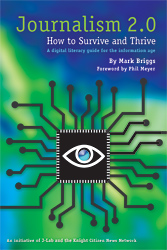Editor’s Note: I Can Has Cheezburger? and Failblog.org anchor the Cheezburger Network–the leading online destination for user-generated humor and entertainment content. As part of the team behind Cheezburger, I asked Scott Porad if he would share how some of their experiences might be relevant to the future of journalism. This post is the first of his two posts on that topic.
In my view, Cheezburger and news journalism are both in the media business. Although news journalism is arguably more important to society than LOLcats (arguably!), the business models are basically the same: we acquire content (either through licensing or by hiring people to create it), and then monetize that content, typically through advertising and subscriptions.
 Compared to traditional humor and entertainment media companies, by relying on user-generated content to harness the wit and intelligence of our community, Cheezburger has found a way to acquire content at a lower cost. This is a significant competitive advantage for us. At the same time, thanks to the power of crowd-sourcing, the content is higher in quality and more relevant than what we could create on our own.
Compared to traditional humor and entertainment media companies, by relying on user-generated content to harness the wit and intelligence of our community, Cheezburger has found a way to acquire content at a lower cost. This is a significant competitive advantage for us. At the same time, thanks to the power of crowd-sourcing, the content is higher in quality and more relevant than what we could create on our own.
 But there’s a catch: the important lesson from Cheezburger’s success with user-generated content is that while content costs less, it is not free. That is, even though we do not pay our users for the content they contribute, there is still a cost associated with acquiring and managing that content. Why? Because only a fraction of the content submitted to us is of high enough quality to be used.
But there’s a catch: the important lesson from Cheezburger’s success with user-generated content is that while content costs less, it is not free. That is, even though we do not pay our users for the content they contribute, there is still a cost associated with acquiring and managing that content. Why? Because only a fraction of the content submitted to us is of high enough quality to be used.
As a result, we incur significant expense to sift and filter and sort through the submissions to find the best. Specifically, we employ a four-stage review process — two phases leverage the user community to help us filter content and two phases of review are done by moderators employed by our company.
Whether employees or users, all of our content moderation is done by humans which is not cheap. We have developed technology to streamline that process, thereby lowering the expense, but we have yet to find an effective way to automate it completely. (Truth be told, we haven’t actually tried that hard to automate it because the primary content on Cheezburger is video and images which are very expensive to machine process. Perhaps it will be worth the investment in the future.)
Regardless, even including the moderation expense, the resulting content costs us less to acquire and is undoubtedly of higher quality. This fundamental win-win is the promise of crowd-sourcing and user-generated content. By committing to the model, Cheezburger has built a profitable business, “something that few others online—not even YouTube—have been able to pull off”. [Slate, March 20, 2009]
Next: What Can News Journalism Learn from I Can Has Cheezburger?
Scott Porad is the part of the team behind I Can Has Cheezburger? and the Cheezburger Network, the leading online destination for user-generated humor and entertainment content. Scott writes about web startups, new media and miscelleany at http://scottporad.com, and you can follow him at http://twitter.com/scottporad.
 Mark Briggs
Mark Briggs  Posted in
Posted in 





The mixed martial arts promotion announced its July 23 card on Monday, and UFC President Dana White remained determined to hold the event less than two weeks after the coronavirus pandemic, though he did not announce a date for the UFC 249 fight card or other details about the card. Tony Ferguson vs Justin Gaethje Live
new websites to review